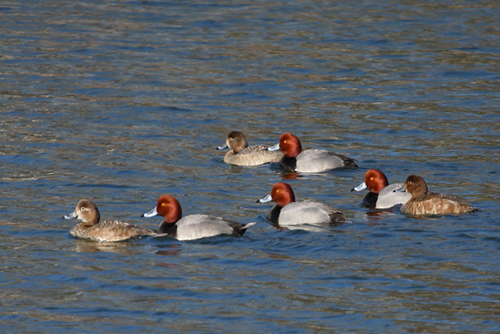BY Lee McClellan
FRANKFORT, Ky. – The wet spring earlier this year left abundant food for waterfowl to eat this fall. This should make for productive hunting when the both duck and goose hunting seasons open Thanksgiving Day, Nov. 28.
“The waterfowl foods that grow in moist soils did excellent in late summer and came on strong,” said Rocky Pritchert, migratory bird coordinator for the Kentucky Department of Fish and Wildlife Resources. “We have really lush growth. It looks like it is going to be a productive waterfowl season across the state.”

Pritchert said waterfowl habitat conditions are good overall across Kentucky, but some areas are better than others. “Because of the wet spring, we were not able to get some of our food crops sown on some of the wildlife management areas (WMAs) until late this year,” he explained.
Waterfowl hunters need to remember that Cedar Creek Lake and Dix River WMAs in Lincoln County along with J.C. Williams WMA in Nelson County now have earlier closures for the upcoming waterfowl seasons. Hunters must cease hunting and be off these areas by 2 p.m. and may not enter them until 4 a.m.
Current U.S. Fish and Wildlife Service population studies show about 45.6 million ducks in their annual survey area. Mallards are the most numerous ducks at 10.3 million birds.
Migration reports show many mallard ducks just to the north of Kentucky. “We had a good hatch this year and anticipation is high,” he said. “The northern breeding duck numbers look really good, a big improvement over last year when drought limited duck reproduction somewhat.”
Kentucky deer hunters, including Pritchert, report seeing many wood ducks this year while hunting. “Their plumage is looking good this year,” Pritchert said. “The wood ducks are really colorful. They are common in central and west Kentucky.”
Eastern Kentucky is home to many black ducks which find Kentucky’s habitat and climate hospitable. “We are the second largest harvest state in the Mississippi Flyway for black ducks,” Pritchert said. “They are more common in eastern Kentucky than other parts of the state.”
Resident Canada goose numbers in Kentucky remain stable after good reproduction this past spring. Hunters can find them from the Mississippi River in the west to Pike County’s Breaks Canyon in the east.
Smaller waters such as farm ponds, rivers and large creeks offer excellent Canada goose hunting opportunities.
“You’ve got to go and hunt,” Pritchert said. “You can’t hunt waterfowl from behind a desk.”
Duck season closes Jan. 26 while goose seasons including Canada goose, white-fronted goose, brant and snow goose close Jan. 31. Hunters must have a valid Kentucky hunting license, Kentucky waterfowl permit and Federal waterfowl permit, commonly called a duck stamp, to hunt waterfowl.
For more information on waterfowl hunting, pick up a copy of the 2013-2014 Kentucky Hunting Guide for Waterfowl available wherever hunting licenses are sold. You may also download a printable version from the Kentucky Fish and Wildlife website at fw.ky.gov.
Author Lee McClellan is an award-winning associate editor for Kentucky Afield magazine, the official publication of the Kentucky Department of Fish and Wildlife Resources. He is a life-long hunter and angler, with a passion for smallmouth bass fishing.
-30-
The Kentucky Department of Fish and Wildlife Resources manages, regulates, enforces and promotes responsible use of all fish and wildlife species, their habitats, public wildlife areas and waterways for the benefit of those resources and for public enjoyment. Kentucky Fish and Wildlife is an agency of the Tourism, Arts and Heritage Cabinet. For more information on the department, visit our website at fw.ky.gov.


Be the first to comment